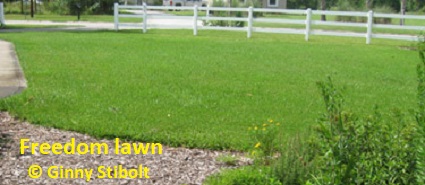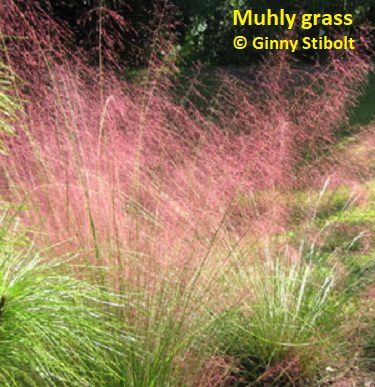The science behind southern grasses, including turf
By Ginny Stibolt
 When my husband and I moved to northeast Florida in 2004, we
inherited a St. Augustine lawn that had been weed & feed'ed, fertilized,
irrigated, sprayed with pesticides and herbicides--all the typical actions
people in Florida have been advised to take in order to maintain their
lawns. We stopped all the chemicals and have irrigated only when needed.
The irrigation system pumps water from a nutrient-rich lake, so each
time we run the irrigation system, we essentially feed the lawn. We
don't mow the lawn when it's dormant--from November to March. Under
our no-chemicals care, there are still quite a few areas where the St.
Augustine is doing well, but there are others where different grasses,
clovers, and many other plants have moved in. It looks quite presentable
as a lawn despite our not spending all that money on chemicals. This
type of lawn, where we mow whatever is there, is called a "freedom lawn." When my husband and I moved to northeast Florida in 2004, we
inherited a St. Augustine lawn that had been weed & feed'ed, fertilized,
irrigated, sprayed with pesticides and herbicides--all the typical actions
people in Florida have been advised to take in order to maintain their
lawns. We stopped all the chemicals and have irrigated only when needed.
The irrigation system pumps water from a nutrient-rich lake, so each
time we run the irrigation system, we essentially feed the lawn. We
don't mow the lawn when it's dormant--from November to March. Under
our no-chemicals care, there are still quite a few areas where the St.
Augustine is doing well, but there are others where different grasses,
clovers, and many other plants have moved in. It looks quite presentable
as a lawn despite our not spending all that money on chemicals. This
type of lawn, where we mow whatever is there, is called a "freedom lawn."
When researching my book, "Sustainable Gardening for Florida," I found
lots of information on how to maintain turf so that it is green all
the time. Most of the sources provided the same advice: fertilize several
times per year, over-seed with annual rye in the winter, apply pre-emergence
herbicide, and poison all the bugs. I was looking for information on
more sustainable lawn care, but this advice varied widely. I finally
decided to take the consensus approach and also relied on practices
that worked for me in the Mid-Atlantic States. My advice on fertilizing
was to do so only once a year, if needed, and to do so after the hurricane
season is over in November. I was wrong. I had not taken into account
the science--that southern grasses use a more efficient photosynthesis
process.
Photosynthesis
Photosynthesis is the process that green plants use to turn carbon dioxide and water into sugar and oxygen with
the energy from sunlight.
Respiration is the reverse process whereby plants and animals use sugars from food and oxygen from the atmosphere
to gain energy for living. The byproducts of respiration, carbon dioxide and water, are usually released into the
atmosphere.
Heat will shut down photosynthesis in most plants when they close the pores (stomata) on their leaves to protect
against dehydration. Carbon dioxide is not available from the air when the stomata are closed. When these plants
respire, carbon dioxide and water are released into the atmosphere through the open stomata. But when the stomata
are closed, respiration is also slowed. Because this method of photosynthesis creates sugars with multiples of
three carbon atoms, this is called the "C3 pathway" for photosynthesis. This type of photosynthesis can take
place in relatively weak light and cool weather, but not in the heat of a summer day.
 In contrast, many
plants that thrive in hot weather have a different, more efficient process
for photosynthesis than plants that use the standard C3 photosynthetic
process. These hot-weather plants include southern grasses used for
lawns such as Bahia grass, Bermuda grass, Centipede grass, Seashore
Paspalum, St. Augustine grass, and Zoysia grass. Other plants in the
grass family, such as corn, cord grass, muhly grass (See photo to the
left.), sugar cane, goose grass, switch grass, and crab grass; plus
some non-grasses including spurge and purslane also use this variant
process. In contrast, many
plants that thrive in hot weather have a different, more efficient process
for photosynthesis than plants that use the standard C3 photosynthetic
process. These hot-weather plants include southern grasses used for
lawns such as Bahia grass, Bermuda grass, Centipede grass, Seashore
Paspalum, St. Augustine grass, and Zoysia grass. Other plants in the
grass family, such as corn, cord grass, muhly grass (See photo to the
left.), sugar cane, goose grass, switch grass, and crab grass; plus
some non-grasses including spurge and purslane also use this variant
process.
These heat-tolerant plants use a more efficient method or the C4 pathway
whereby the photosynthesis can continue during hot days even when their
stomata are closed. They produce starch, which is a complex sugar with
multiples of four carbon atoms, instead of a simple sugar. Also when
C4 plants respire, the carbon dioxide and water are not released into
the atmosphere, but are absorbed chemically and become available for
photosynthesis. Since their respiration process retains water, C4 plants
are also better equipped to handle drought. (See the Wikipedia reference
below for the detailed chemistry of C3 & C4 pathways.)
The ideal soil temperatures that favor maximum root growth for C3 plants
are 55 to 65 degrees, but the ideal temperature range is 75 to 95 degrees
for the C4 plants. For the crown growth, C3 plants do best with air
temperatures from 60 to 77 degrees, while C4 plants do best at 85 to
117 degrees!
On the other hand, C4 plants become dormant in cool weather and are
not particularly shade tolerant. C3 plants do fine in cooler weather
and many are quite tolerant of the shade because the lower temperature
in the shade enables them to photosynthesize for more hours during hot
days.
C3 vs. C4: What's the significance?
The significance of this different chemistry is that the hot-weather-loving
C4 plants should not be lumped into a one-size-fits-all type of lawn
care. The typical advice for minimum lawn care is to fertilize with
a slow-release fertilizer or compost in the fall. This is bad advice
for C4 turf because it will be going into dormancy with cooler weather
and shorter days. That fertilizer will sit there unused except by weeds,
or the late fall storms will rinse it off the landscape into the waterways
via the storm drainage systems.
The better advice for minimum care of warm weather grasses is to fertilize
(if you absolutely must) only once in the spring (well before the onset
of the wet season) with a slow release fertilizer and/or compost after
the grass begins to green up with the approach of warmer weather and
longer days. So if you're managing a lawn with southern grasses, don't
use the standard Yankee advice.
Resources:
· A column in the New York Times "Evolution
by the Grassroots" by Olivia Judson.
·
Wikipedia provides more details on the C4 photosynthesis chemistry.
|


 When my husband and I moved to northeast Florida in 2004, we
inherited a St. Augustine lawn that had been weed & feed'ed, fertilized,
irrigated, sprayed with pesticides and herbicides--all the typical actions
people in Florida have been advised to take in order to maintain their
lawns. We stopped all the chemicals and have irrigated only when needed.
The irrigation system pumps water from a nutrient-rich lake, so each
time we run the irrigation system, we essentially feed the lawn. We
don't mow the lawn when it's dormant--from November to March. Under
our no-chemicals care, there are still quite a few areas where the St.
Augustine is doing well, but there are others where different grasses,
clovers, and many other plants have moved in. It looks quite presentable
as a lawn despite our not spending all that money on chemicals. This
type of lawn, where we mow whatever is there, is called a "freedom lawn."
When my husband and I moved to northeast Florida in 2004, we
inherited a St. Augustine lawn that had been weed & feed'ed, fertilized,
irrigated, sprayed with pesticides and herbicides--all the typical actions
people in Florida have been advised to take in order to maintain their
lawns. We stopped all the chemicals and have irrigated only when needed.
The irrigation system pumps water from a nutrient-rich lake, so each
time we run the irrigation system, we essentially feed the lawn. We
don't mow the lawn when it's dormant--from November to March. Under
our no-chemicals care, there are still quite a few areas where the St.
Augustine is doing well, but there are others where different grasses,
clovers, and many other plants have moved in. It looks quite presentable
as a lawn despite our not spending all that money on chemicals. This
type of lawn, where we mow whatever is there, is called a "freedom lawn." In contrast, many
plants that thrive in hot weather have a different, more efficient process
for photosynthesis than plants that use the standard C3 photosynthetic
process. These hot-weather plants include southern grasses used for
lawns such as Bahia grass, Bermuda grass, Centipede grass, Seashore
Paspalum, St. Augustine grass, and Zoysia grass. Other plants in the
grass family, such as corn, cord grass, muhly grass (See photo to the
left.), sugar cane, goose grass, switch grass, and crab grass; plus
some non-grasses including spurge and purslane also use this variant
process.
In contrast, many
plants that thrive in hot weather have a different, more efficient process
for photosynthesis than plants that use the standard C3 photosynthetic
process. These hot-weather plants include southern grasses used for
lawns such as Bahia grass, Bermuda grass, Centipede grass, Seashore
Paspalum, St. Augustine grass, and Zoysia grass. Other plants in the
grass family, such as corn, cord grass, muhly grass (See photo to the
left.), sugar cane, goose grass, switch grass, and crab grass; plus
some non-grasses including spurge and purslane also use this variant
process.